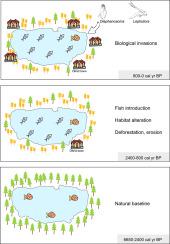当前位置:
X-MOL 学术
›
Palaeogeogr. Palaeoclimatol. Palaeoecol.
›
论文详情
Our official English website, www.x-mol.net, welcomes your
feedback! (Note: you will need to create a separate account there.)
Ancient civilizations already had an impact on cladoceran assemblages in Europe's oldest lake
Palaeogeography, Palaeoclimatology, Palaeoecology ( IF 2.6 ) Pub Date : 2020-08-01 , DOI: 10.1016/j.palaeo.2020.109734 C. López-Blanco , O. Tasevska , G. Kostoski , B. Wagner , T. Wilke
Palaeogeography, Palaeoclimatology, Palaeoecology ( IF 2.6 ) Pub Date : 2020-08-01 , DOI: 10.1016/j.palaeo.2020.109734 C. López-Blanco , O. Tasevska , G. Kostoski , B. Wagner , T. Wilke

|
Abstract Lake Ohrid (Republic of North Macedonia) is the oldest and most biodiverse freshwater lake in Europe. While the lake has recently been under severe anthropogenic pressure, historical impacts are poorly studied. We used paleolimnological information, particularly from cladoceran assemblages, to describe the long-term anthropogenic impacts that the lake has experienced over the last 6650 years. Multivariate analyses of cladoceran abundances together with selected environmental indicators were used to distinguish natural from human impacts and to track the direction and causes of observed changes. In addition, morphological analyses of planktonic Bosmina allowed us to assess the effects of fisheries and aquaculture on cladoceran phenotypic plasticity. Our findings reveal that the lake has been regularly exposed to anthropogenic impacts during the last millennia, including habitat deterioration, shifts in the food web and species introductions. Before 2400 cal yr BP, cladocerans showed the highest diversity values, and the relatively larger size of Bosmina longirostris indicated limited zooplanktivory. Since 2400 cal yr BP, coinciding with the foundation of the town of Ohrid and elevated erosion and deforestation, there has been a progressive loss of littoral taxa. Since 1700 cal yr BP, fish introductions have increased, inducing morphological changes in Bosmina, which resulted in a significant decrease in body size and antennule length and an increase in mucro and antennule angle. We also show that the present-day cladoceran community differs from the prehistoric community due to the invasion of Diaphanosoma. Overall, our results highlight the sensitivity of this unique ecosystem to human alterations, which began before the Anthropocene.
中文翻译:

古代文明已经对欧洲最古老湖泊中的枝角类动物群产生了影响
摘要 奥赫里德湖(北马其顿共和国)是欧洲最古老、生物多样性最丰富的淡水湖。虽然该湖最近受到严重的人为压力,但对历史影响的研究却很少。我们使用古湖水学信息,特别是来自枝角类动物组合的信息,来描述该湖在过去 6650 年中所经历的长期人为影响。枝角类动物丰度的多变量分析与选定的环境指标一起用于区分自然影响和人类影响,并跟踪观察到的变化的方向和原因。此外,浮游 Bosmina 的形态分析使我们能够评估渔业和水产养殖对枝角类表型可塑性的影响。我们的研究结果表明,在过去的几千年里,该湖经常受到人为影响,包括栖息地恶化、食物网的变化和物种引入。在 2400 cal yr BP 之前,枝角类动物表现出最高的多样性值,而 Bosmina longirostris 的相对较大的尺寸表明浮游动物食量有限。自 2400 cal yr BP 以来,恰逢奥赫里德镇的建立以及侵蚀和森林砍伐加剧,沿海分类群逐渐丧失。自 1700 cal yr BP 以来,鱼的引入量增加,导致 Bosmina 的形态变化,导致体型和触角长度显着减小,并增加了 mucro 和触角角度。我们还表明,由于 Diaphanosoma 的入侵,当今的枝角类群落与史前群落不同。总的来说,我们的结果突出了这个独特的生态系统对人类改变的敏感性,人类改变始于人类世。
更新日期:2020-08-01
中文翻译:

古代文明已经对欧洲最古老湖泊中的枝角类动物群产生了影响
摘要 奥赫里德湖(北马其顿共和国)是欧洲最古老、生物多样性最丰富的淡水湖。虽然该湖最近受到严重的人为压力,但对历史影响的研究却很少。我们使用古湖水学信息,特别是来自枝角类动物组合的信息,来描述该湖在过去 6650 年中所经历的长期人为影响。枝角类动物丰度的多变量分析与选定的环境指标一起用于区分自然影响和人类影响,并跟踪观察到的变化的方向和原因。此外,浮游 Bosmina 的形态分析使我们能够评估渔业和水产养殖对枝角类表型可塑性的影响。我们的研究结果表明,在过去的几千年里,该湖经常受到人为影响,包括栖息地恶化、食物网的变化和物种引入。在 2400 cal yr BP 之前,枝角类动物表现出最高的多样性值,而 Bosmina longirostris 的相对较大的尺寸表明浮游动物食量有限。自 2400 cal yr BP 以来,恰逢奥赫里德镇的建立以及侵蚀和森林砍伐加剧,沿海分类群逐渐丧失。自 1700 cal yr BP 以来,鱼的引入量增加,导致 Bosmina 的形态变化,导致体型和触角长度显着减小,并增加了 mucro 和触角角度。我们还表明,由于 Diaphanosoma 的入侵,当今的枝角类群落与史前群落不同。总的来说,我们的结果突出了这个独特的生态系统对人类改变的敏感性,人类改变始于人类世。











































 京公网安备 11010802027423号
京公网安备 11010802027423号